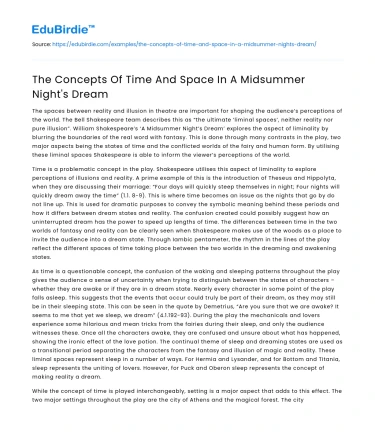The spaces between reality and illusion in theatre are important for shaping the audience’s perceptions of the world. The Bell Shakespeare team describes this as “the ultimate ‘liminal spaces’, neither reality nor pure illusion”. William Shakespeare’s ‘A Midsummer Night’s Dream’ explores the aspect of liminality by blurring the boundaries of the real word with fantasy. This is done through many contrasts in the play, two major aspects being the states of time and the conflicted worlds of the fairy and human form. By utilising these liminal spaces Shakespeare is able to inform the viewer’s perceptions of the world.
Time is a problematic concept in the play. Shakespeare utilises this aspect of liminality to explore perceptions of illusions and reality. A prime example of this is the introduction of Theseus and Hippolyta, when they are discussing their marriage: “Four days will quickly steep themselves in night; Four nights will quickly dream away the time” (1.1. 8-9). This is where time becomes an issue as the nights that go by do not line up. This is used for dramatic purposes to convey the symbolic meaning behind these periods and how it differs between dream states and reality. The confusion created could possibly suggest how an uninterrupted dream has the power to speed up lengths of time. The differences between time in the two worlds of fantasy and reality can be clearly seen when Shakespeare makes use of the woods as a place to invite the audience into a dream state. Through Iambic pentameter, the rhythm in the lines of the play reflect the different spaces of time taking place between the two worlds in the dreaming and awakening states.
Save your time!
We can take care of your essay
- Proper editing and formatting
- Free revision, title page, and bibliography
- Flexible prices and money-back guarantee
As time is a questionable concept, the confusion of the waking and sleeping patterns throughout the play gives the audience a sense of uncertainty when trying to distinguish between the states of characters – whether they are awake or if they are in a dream state. Nearly every character in some point of the play falls asleep. This suggests that the events that occur could truly be part of their dream, as they may still be in their sleeping state. This can be seen in the quote by Demetrius, “Are you sure that we are awake? It seems to me that yet we sleep, we dream” (4.1.192-93). During the play the mechanicals and lovers experience some hilarious and mean tricks from the fairies during their sleep, and only the audience witnesses these. Once all the characters awake, they are confused and unsure about what has happened, showing the ironic effect of the love potion. The continual theme of sleep and dreaming states are used as a transitional period separating the characters from the fantasy and illusion of magic and reality. These liminal spaces represent sleep in a number of ways. For Hermia and Lysander, and for Bottom and Titania, sleep represents the uniting of lovers. However, for Puck and Oberon sleep represents the concept of making reality a dream.
While the concept of time is played interchangeably, setting is a major aspect that adds to this effect. The two major settings throughout the play are the city of Athens and the magical forest. The city is structured and ordered whereas the forest is place for anarchy. Shakespeare creates two different universes that have the ability to connect in diverse ways, however they have the capability to co-exist even through their differences. The outcome of the consistency of Titania and Oberon’s fighting is representing the climates unpredictable traits. As a result of their dispute, it is further emphasised that their conflict is not confined to the magical forest but further extended to the real world. “Contagious fogs; which falling in the land” (2.1.90), “The childing autumn, angry winter change” (2.1.112) show how the quarrel between Titania and Oberon has altered the native climate of the seasons. This aspect of liminality shows how the various weather states are symbolising the consequences of arguments and how this can cause hardship, even between characters of the mystical world. From this, the play replaces the well-known world where government structures society into a disordered world with no laws. Waking and sleeping, day and night, love and abuse, and court and forest builds numerous kinds of states, and because of this, most characters struggle to know what space they are truly in.
The forest is a strong symbol of untamed nature that is tied to the illusion of the world of fairies. Because of this Shakespeare is able to benefit the audience by letting them experience travel, parting Athens and arriving into a new universe and welcoming the audience to experience a dream. On their journey through the liminal spaces of the play, Shakespeare utilises the forest setting as a land of chaos more so than a land of order. When Puck says “Through the forest have I gone… Night and silence – Who is here?” (2.2.72-76), it shows how dreams have the capability to confuse and even strip someone of an identity. This space between the two worlds allows the audience to formulate their own perception of illusion versus reality. It pushes viewers to see through spaces of liminality the effects behind the dream state.
By making use of the conflicting aspects of time between the waking and sleeping states as well as the two worlds of the play, William Shakespeare is able to blur together illusion and reality to inform the audience’s views on the world. These liminal spaces invite the viewer into the settings of ‘A Midsummer Night’s Dream’ through the contrasts between the human and fairy form and through how time differs between each of their worlds. These become the most important aspects for shaping its audience’s perceptions.






 Stuck on your essay?
Stuck on your essay?

